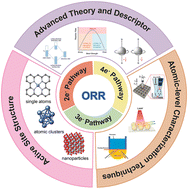The oxygen reduction reaction (ORR), involving multiple electron pathways and a variety of reduction products, plays a pivotal role in various renewable energy applications and environmental pollutant treatment technologies. Atomically dispersed catalysts (ADCs) have emerged as a forefront in the field of catalysis due to their novel catalytic mechanisms and enhanced catalytic activity. The specific ORR pathway often depends on the electronic/geometric structure of the ADCs and the adsorption state of oxygen-containing species. However, the systematic comprehension of the intrinsic relationship between local structure and path selectivity (i.e. 1e−, 2e−, 3e−, 4e−) is still lacking. This review provides an overview of the primary ORR pathways and their associated mechanisms, along with a discussion of advanced theories and descriptors used to predict and analyze ORR performance. Subsequently, the intrinsic relationship between the local atomic structure of ADCs and their ORR pathway selectivity is summarized. Then, advanced characterization techniques are classified to reveal the precise structure and real active sites of ADCs. Finally, the potential challenges and perspectives toward understanding and developing efficient ADCs are presented. This review will provide new inspiration for the development of highly selective ADCs for clean energy conversion technologies.
